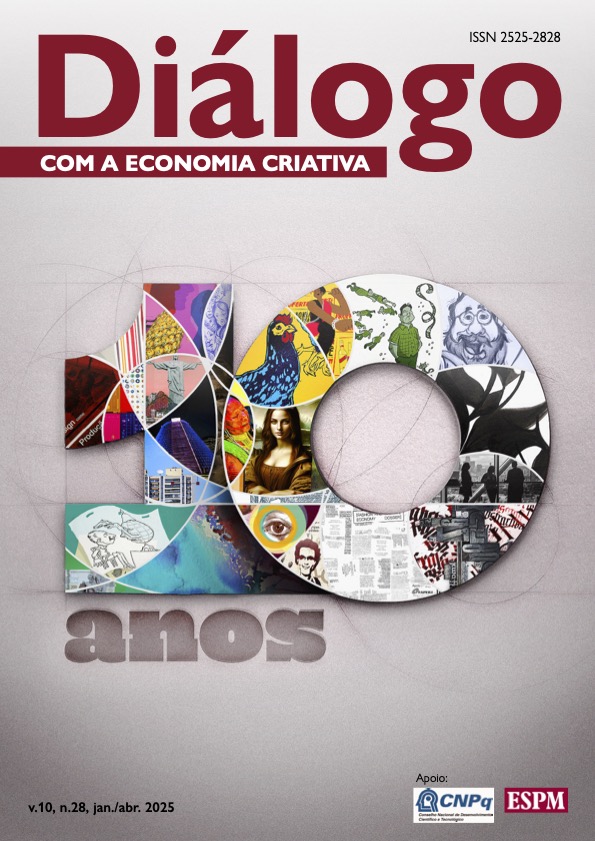Afro-Brazilian liturgical clothing market in Southern Brazil: a comparison between three companies
DOI:
https://doi.org/10.22398/2525-2828.925131-150Keywords:
Liturgical clothing, Afro-Brazilian, Product mix, Marketing mix, E-commerceAbstract
This article aimed to carry out a comparative analysis between three companies in the Afro Brazilian liturgical clothing segment located in the South region of Brazil using product mix and marketing tools. For this research, the inductive method was applied, with an applied purpose, with qualitative data analysis and descriptive from the point of view. Among the technical pro cedures, the preparation of the bibliographic research was based on an unsystematic review and online field research to identify the intentional samples analyzed in this study. The result obtained allowed the creation of a comparative table of the aforementioned companies, their common points and their market differences.
References
ANDERSON, Chris. A cauda longa: do mercado de massa para o mercado de nicho. Rio de Janeiro: Elsevier, 2006.
BAHNG, Youngjin; KINCADE, Doris H. Retail buyer segmentation based on the use of assortment decision factors. Journal of Retailing and Consumer Services, v. 21, n. 4, p. 643-652, 2014. https://doi.org/10.1016/j.jretconser.2013.12.004
BARBOSA, Cristina Rodrigues. Roadmap para o processo de desenvolvimento de mix de produtos aplicado ao varejo de vestuário. 171f. Dissertação (Mestrado) – Programa de Pós-Graduação em Moda, Ceart, Universidade do Estado de Santa Catarina, Florianópolis, 2021.
BARBOSA, Cristina Rodrigues; SEIBEL, Silene. Mix de produtos. Florianópolis: Udesc, 2021a. 18 p. Disponível em: https://www.udesc.br/arquivos/ceart/id_cpmenu/10685/E_book_Mix_de_produtos_16130813143681_10685.pdf. Acesso em: 12 mar. 2023.
BARBOSA, Cristina Rodrigues; SEIBEL, Silene. Riscos na moda: recomendações associadas ao desenvolvimento de mix de produtos de vestuário no varejo sob ótica de especialistas. Modapalavra E-Periódico, Florianópolis, v. 14, n. 34, p. 284-307, 30 set. 2021b. https://doi.org/10.5965/1982615x14342021284
CAMPOS, Zuleica Dantas Pereira. Axós em evidência: uma análise da indumentária litúrgica afrobrasileira no Recife. In: CONGRESSO INTERNACIONAL DA SOTER, 28., 2015. Anais [...]. 2015.
CIETTA, E. A economia da moda. São Paulo: Estação das Letras e Cores, 2017.
GAMA, Luciana Barros. Laroyê! Exu: os caminhos que levam ao mercado consumo religioso afrobrasileiro no Recife – PE. 185f. Tese (Doutorado) – Programa de Pós-Graduação em Antropologia, Centro de Filosofia e Ciências Humanas, Universidade Federal de Pernambuco, Recife, 2016. Disponível em: https://repositorio.ufpe.br/bitstream/123456789/28983/4/TESE%20Luciana%20Barros%20Gama.pdf. Acesso em: 25 maio 2023.
GONÇALVES, Fernanda Paula Silva; SILVA, Carlos Henrique Osório; SILVA, Fernanda Cristina da; XAVIER, Wescley Silval; TAVARES, Bruno. O impacto das certificações de RSE sobre o comportamento de compra do consumidor. In: ENCONTRO NACIONAL DA ASSOCIAÇÃO NACIONAL DOS PROGRAMAS DE PÓS-GRADUAÇÃO EM ADMINISTRAÇÃO, 32., 2008, Rio de Janeiro. Anais […]. Rio de Janeiro: Anpad, 2008.
GUIMARÃES, Julliana de Almeida; RODRIGUES, Alfredo Sotero Alves. Comunicação e o universo on-line das indumentárias do povo de santo. In: CONGRESSO BRASILEIRO DE CIÊNCIAS DA COMUNICAÇÃO, 38., 2015, Rio de Janeiro. Anais [...]. Rio de Janeiro: Intercom – Sociedade Brasileira de Estudos Interdisciplinares da Comunicação, 2015. Disponível em: https://www.portalintercom.org.br/anais/nacional2015/resumos/R10-3306-1.pdf. Acesso em: 5 maio 2023.
HASKER, Kevin; SICKLES, Robin. EBay in the Economic Literature: analysis of an auction marketplace. Review of Industrial Organization, v. 37, n. 1, p. 3-42, ago. 2010. https://doi.org/10.1007/s11151-010-9257-5
IDRIS, Junainah. Marketing mix 4Cs: impact on small and medium entrepreneurs (SMES) marketing performance. Journal of Management e Muamalah, Kajang, v. 8, n. 8, p. 221-226, 8 jun. 2021. Disponível em: http://conference.kuis.edu.my/icomm/8th/images/021-113.pdf. Acesso em: 20 maio 2023.
INSTITUTO BRASILEIRO DE GEOGRAFIA E ESTATÍSTICA (IBGE). Censo demográfico 2010: Características gerais da população, religião e pessoas com deficiência. Rio de Janeiro: IBGE, 2010. 211 p. Disponível em: https://biblioteca.ibge.gov.br/visualizacao/periodicos/94/cd_2010_religiao_deficiencia.pdf. Acesso em: 24 out. 2022.
IYEMONJA, Baba Diba de. Comunidade tradicional de terreiro: Batuque do RS e o racismo religioso. Porto Alegre: Sindicato dos Servidores da Justiça do Rio Grande do Sul, 2020. Disponível em: http://www.sindjus.com.br/comunidade-tradicional-de-terreiro-batuque-do-rs-e-o-racismoreligioso/12607/. Acesso em: 20 nov. 2023.
KOTLER, Philip; KARTAJAYA, Hermawan; SETIAWAN, Iwan. Marketing 4.0: do tradicional ao digital. Rio de Janeiro: Sextante, 2017. 257 p.
KOTLER, Philip; KARTAJAYA, Hermawan; SETIAWAN, Iwan. Marketing 5.0: tecnologia para a humanidade. Rio de Janeiro: Sextante, 2021. 216 p.
KOTLER, Philip; KELLER, Kevin L. Administração de Marketing. 12. ed. São Paulo: Pearson Prentice Hall, 2006.
ORO, Ari Pedro. Religião e mercado no Cone-Sul: as religiões afrobrasileiras como negócio. In: REUNIÃO ANUAL DA ANPOCS, 22., 1998, Caxambu. Anais [...]. v. 22, n. 22, p. 1-31, 31 out. 1998.
PARENTE, Juracy; BARKI, Edgard. Varejo no Brasil: gestão e estratégia. 2. ed. São Paulo: Atlas, 2014.
PRANDI, Reginaldo. As religiões afro-brasileiras e seus seguidores. Civitas, Porto Alegre, v. 3, n. 1, p. 15-33, 2007. https://doi.org/10.15448/1984-7289.2003.1.108
RONGXUAN, Duan. Analysis method of marketing. Aktual’Nyye Problemy Aviatsii I Kosmonavtiki, Krasnoyarsky, v. 2, n. 2, p. 719-721, fev. 2019. Disponível em: https://cyberleninka.ru/article/n/analysis-method-of-marketing. Acesso em: 7 maio 2023.
TEIXEIRA, Talita Bender. Trapo formoso: o vestuário na Quimbanda. 126f. Dissertação (Mestrado em Antropologia Social) – Universidade Federal do Rio Grande do Sul, Porto Alegre, 2005.
Downloads
Published
How to Cite
Issue
Section
License

This work is licensed under a Creative Commons Attribution-NonCommercial-NoDerivatives 4.0 International License.
The copyright for articles published in this journal belongs to the author, with first publication rights to the journal.
We emphasize that the responsibility for the articles is exclusive to the author(s) and does not necessarily reflect the opinion of the Editors or ESPM.








